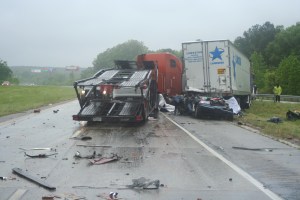My family has been through a lot in the aftermath of our truck crash on May 4, 2013. They each have their own story (some more closely-guarded than others). I was surprised but pleased that one of our sons was able to take the time to express his thoughts in the form of a Comment on our Vision Zero Petition a couple of hours ago.
Isaac said that I could share his comments here:
“Three years ago, I was sitting in my apartment, working on my class projects, when I got a phone call that turned my world upside down. My family’s car had been hit by a truck, and I was the first person that the hospital was able to reach. There was a lot of confusion; no one knew where my two sisters who had been in the back seat of the car had been taken.
“I had a pair of dice in my pocket that day, the same pair of dice that I had when my father called me later that evening with the news that my sister had died in the crash. Humans are bad at estimating probabilities. A one-in-a-million chance sounds rare, but that’s close to the odds the NWS reports for being struck by lightning, and 330 Americans are injured that way every year. It’s rare, but it happens. In probability theory, it’s called the law of large numbers. If you roll the dice often enough, or for enough people, the dice are going to come up as ones at a predictable, measurable rate.
“The IIHS reported that in 2013, there were 10.3 deaths from motor vehicle crashes per 100,000 people. That’s about one-in-ten-thousand, way more likely than one-in-a-million. And, unlike other leading causes of death, this is an entirely human-created problem, one that didn’t exist two hundred years ago.
“Automotive safety has been improving over time. But it is still one of the leading causes of death in America. Curing cancer, one of the other leading causes, is expensive and difficult, requiring research just to figure out if it is even possible. In contrast, for motor vehicle deaths there are many cases where we already know simple ways to reduce motor vehicle fatalities, such as effective underride guards, and we have promising research for even more.
“We shouldn’t settle for one-in-ten thousand, or even one-in-a-hundred-thousand. We should strive to be better than that. Human lives shouldn’t be a nickel and dime proposition. Even low chances of death are still too high. I shouldn’t have to roll the dice every time I need to leave my house. I shouldn’t have to wonder, every time my family is out on the road, if today is going to be the day that they roll too many ones again.”
To all the creative people: I recently lost someone close to me. She didn’t know how creative she was and how talented she was becoming, but I did. She didn’t think that she would be able to live up to her siblings. She doubted her talent. She was embarrassed when anyone read her writing. But she kept reading, writing, making.
She was one of the people I relied on to find out about new books. I was counting on her writing the kinds of books I wanted to read. I didn’t realize how much I was expecting from her future until it was gone.
Every death is an irreplaceable loss, but that doesn’t mean we stop living. The absence left behind can’t be filled in this life. That’s all the more reason to build a monument to her memory. I can’t replace her life or her lost works, but I can create my own. They will be different than what could have been, because they’ll be my creations instead of hers. I can’t be her. I can be myself. My works can reflect the life and the hope she believed in, because I have the same hope. I am not justified by my merits (or by hers). I can do my best and no more. That won’t be enough, but it will be right.
To the writers, the readers, the makers, the designers: keep creating. The night will be long and the shadows of your doubts dark. Don’t let that stop you. When you think your work isn’t good enough, it’s a sign to keep going. Your work won’t justify anyone, least of all you, but every creative act that introduces something good to the world is an act of love to those around you.
In memory of those we have lost, and in love to those we have now, I ask you to continue. Keep creating, keep making, keep doing. This is the service you have been given, to love all of creation by creating.













